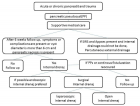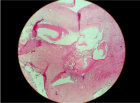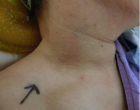Abstract
Research Article
Is secondary prevention information before discharge adequate after percutaneous coronary intervention?
Catrin Henriksson* and Joep Perk
Published: 08 May, 2019 | Volume 4 - Issue 2 | Pages: 012-020
Introduction: Implementation of prevention strategies for patients with coronary artery disease (CAD) is essential, but many fall short of reaching their goals. Patients often perceive themselves as healthy and are less motivated to change lifestyle. To obtain better results patients need repeated information, preferably with motivational and person-centered approaches.
Aims: To investigate whether health care providers inform CAD patients about risk factors and lifestyle changes at a percutaneous coronary intervention unit. Also to investigate whether the information given at discharge included secondary prevention management and if motivational and person-centered approaches were used.
Methods: This is a descriptive, observational study that includes both a qualitative and quantitative design. Physicians and nurses working at a percutaneous coronary intervention (PCI) unit and physicians at a coronary care unit (CCU) participated. A staff nurse observed and noted what information the patients received at the PCI unit. At the CCU, observations regarding secondary prevention strategies during the discharge counselling were performed.
Results: There were 50 observations made at the PCI unit. The information mainly consisted of tobacco consumption, physical activity and diet.
During the 31 discharge counselling sessions the diagnosis, interventional procedure and medical treatment were frequently included. Most patients received little or no person-centered or motivational counselling.
Conclusion: Nearly all patients at the PCI unit received information about the consequence of tobacco consumption, and more than half about the beneficial effects of physical activity. In contrast, the counselling at discharge need to focus more on behavioral changes and a motivational and person-centered approach.
Read Full Article HTML DOI: 10.29328/journal.jccm.1001034 Cite this Article Read Full Article PDF
Keywords:
Patient information; Myocardial infarction; PCI; Person-centered care and motivational interviewing
References
- Organization WH. Joint WHO/FAO Expert Consultation on Diet, Nutrition and the Prevention of Chronic Diseases. 2002. Ref.: https://tinyurl.com/yxn7ovo4
- Authors/Task Force Members:, Piepoli MF, Hoes AW, Agewall S1, Albus C, et al. 2016 European Guidelines on cardiovascular disease prevention in clinical practice: The Sixth Joint Task Force of the European Society of Cardiology and Other Societies on Cardiovascular Disease Prevention in Clinical Practice (constituted by representatives of 10 societies and by invited experts) Developed with the special contribution of the European Association for Cardiovascular Prevention & Rehabilitation (EACPR). Atherosclerosis 2016; 252: 207-274. Ref.: https://tinyurl.com/y4qwr3rq
- Kotseva K, De Backer G, De Bacquer D, Rydén L, Hoes A, et al. Lifestyle and impact on cardiovascular risk factor control in coronary patients across 27 countries: Results from the European Society of Cardiology ESC-EORP EUROASPIRE V registry. Eur J Prev Cardiol. 2019; 2047487318825350. Ref.: https://tinyurl.com/y6ltj3dm
- Perk J, Hambraeus K, Burell G, Carlsson R, Johansson P, et al. Study of Patient Information after percutaneous Coronary Intervention (SPICI): should prevention programmes become more effective? EuroIntervention. 2015; 10: e1-7. Ref.: https://tinyurl.com/y56ehcfc
- Piepoli MF, Corrà U, Benzer W, Bjarnason-Wehrens B, Dendale P, et al. Secondary prevention through cardiac rehabilitation: from knowledge to implementation. A position paper from the Cardiac Rehabilitation Section of the European Association of Cardiovascular Prevention and Rehabilitation. Eur J Cardiovasc Prev Rehabil. 2010; 17: 1-17. Ref.: https://tinyurl.com/y32ak392
- Wijns W, Kolh P, Danchin N, Di Mario C, Falk V, et al. Guidelines on myocardial revascularization. Eur Heart J. 2010; 31: 2501-2555. Ref.: https://tinyurl.com/y47ejbce
- Britt E, Hudson SM, Blampied NM. Motivational interviewing in health settings: a review. Patient Educ Couns. 2004; 53: 147-155. Ref.: https://tinyurl.com/y2kp9yss
- Hardcastle SJ, Taylor AH, Bailey MP, Harley RA, Hagger MS. Effectiveness of a motivational interviewing intervention on weight loss, physical activity and cardiovascular disease risk factors: a randomised controlled trial with a 12-month post-intervention follow-up. Int J Behav Nutr Phys Act. 2013; 10; 40. Ref.: https://tinyurl.com/y4ja992s
- Ekman I, Swedberg K, Taft C, Lindseth A, Norberg A, et al. Person-centered care--ready for prime time. Eur J Cardiovasc Nurs. 2011; 10: 248-251. Ref.: https://tinyurl.com/y5njkn6h
- Fors A, Ekman I, Taft C, Björkelund C, Frid K, et al. Person-centred care after acute coronary syndrome, from hospital to primary care - A randomised controlled trial. Int J Cardiol. 2015; 187; 693-699. Ref.: https://tinyurl.com/y2xjuftz
- Miller NH. Adherence behavior in the prevention and treatment of cardiovascular disease. J Cardiopulm Rehabil Prev. 2012; 32: 63-70. https://tinyurl.com/y5jz3qbv
- Graneheim UH, Lundman B. Qualitative content analysis in nursing research: concepts, procedures and measures to achieve trustworthiness. Nurse Educ Today. 2004; 24: 105-112. Ref.: https://tinyurl.com/yxlebz89
- Rickham PP. Human Experimentation. Code of Ethics of the World Medical Association. Declaration of Helsinki. Br Med J. 2: 177. Ref.: https://tinyurl.com/yxgwzw78
- Alm-Roijer C, Fridlund B, Stagmo M, Erhardt L. Knowing your risk factors for coronary heart disease improves adherence to advice on lifestyle changes and medication. J Cardiovasc Nurs. 2006; 21: E24-31. Ref.: https://tinyurl.com/y3l3qp6t
- Scott JT, Thompson DR. Assessing the information needs of post-myocardial infarction patients: a systematic review. Patient Educ Couns. 2003; 50: 167-177. Ref.: https://tinyurl.com/y4k6kklm
- Ahmed HM, Blaha MJ, Nasir K, Rivera JJ, Blumenthal RS. Effects of physical activity on cardiovascular disease. Am J Cardiol. 2012; 109: 288-295. Ref.: https://tinyurl.com/y5txrosw
- Byberg L, Zethelius B, McKeigue PM, Lithell HO. Changes in physical activity are associated with changes in metabolic cardiovascular risk factors. Diabetologia. 2001; 44: 2134-2139. Ref.: https://tinyurl.com/y4vlrjet
- Giannuzzi P, Mezzani A, Saner H, Björnstad H, Fioretti P, et al. Physical activity for primary and secondary prevention. Position paper of the Working Group on Cardiac Rehabilitation and Exercise Physiology of the European Society of Cardiology. Eur J Cardiovasc Prev Rehabil. 2003; 10: 319-327. Ref.: https://tinyurl.com/yxc95u3m
- Perk J, De Backer G, Gohlke H, Graham I, Reiner Z, et al. European Guidelines on cardiovascular disease prevention in clinical practice (version 2012). The Fifth Joint Task Force of the European Society of Cardiology and Other Societies on Cardiovascular Disease Prevention in Clinical Practice (constituted by representatives of nine societies and by invited experts). Eur Heart J. 2012; 33: 1635-1701. Ref.: https://tinyurl.com/y5phm9q9
- Newby LK, LaPointe NM, Chen AY, Kramer JM, Hammill BG, et al. Long-term adherence to evidence-based secondary prevention therapies in coronary artery disease. Circulation. 206; 113: 203-212. Ref.: https://tinyurl.com/yyotgoqp
- Developed with the special contribution of the European Association for Percutaneous Cardiovascular Interventions (EAPCI), Wijns W, Kolh P, Danchin N, Di Mario C, et al. Guidelines on myocardial revascularization: The Task Force on Myocardial Revascularization of the European Society of Cardiology (ESC) and the European Association for Cardio-Thoracic Surgery (EACTS). Eur Heart J. 2010; 31: 2501-2555. Ref.: https://tinyurl.com/y4ntosdo
- Miller NH. Motivational interviewing as a prelude to coaching in healthcare settings. J Cardiovasc Nurs. 2010; 25: 247-251 Ref.: https://tinyurl.com/y3v5ylxk
- Jackson L, Leclerc J, Erskine Y, Linden W. Getting the most out of cardiac rehabilitation: a review of referral and adherence predictors. Heart. 205; 91: 10-14. Ref.: https://tinyurl.com/y2x4gmmf
Similar Articles
-
Left Atrial Remodeling is Associated with Left Ventricular Remodeling in Patients with Reperfused Acute Myocardial InfarctionChristodoulos E. Papadopoulos*,Dimitrios G. Zioutas,Panagiotis Charalambidis,Aristi Boulbou,Konstantinos Triantafyllou,Konstantinos Baltoumas,Haralambos I. Karvounis,Vassilios Vassilikos. Left Atrial Remodeling is Associated with Left Ventricular Remodeling in Patients with Reperfused Acute Myocardial Infarction. . 2016 doi: 10.29328/journal.jccm.1001001; 1: 001-008
-
Procedure utilization, latency and mortality: Weekend versus Weekday admission for Myocardial InfarctionNader Makki,David M Kline,Arun Kanmanthareddy,Hansie Mathelier,Satya Shreenivas,Scott M Lilly*. Procedure utilization, latency and mortality: Weekend versus Weekday admission for Myocardial Infarction. . 2017 doi: 10.29328/journal.jccm.1001008; 2: 020-025
-
Spontaneous rupture of a giant Coronary Artery Aneurysm after acute Myocardial InfarctionOğuzhan Çelik,Mucahit Yetim,Tolga Doğan,Lütfü Bekar,Macit Kalçık*,Yusuf Karavelioğlu. Spontaneous rupture of a giant Coronary Artery Aneurysm after acute Myocardial Infarction. . 2017 doi: 10.29328/journal.jccm.1001009; 2: 026-028
-
A rare Congenital Coronary Artery Anomaly: Woven Right Coronary Artery associated with Myocardial InfarctionTolga Doğan,Mucahit Yetim,Lütfü Bekar,Oğuzhan Çelik,Macit Kalçık*,Yusuf Karavelioğlu. A rare Congenital Coronary Artery Anomaly: Woven Right Coronary Artery associated with Myocardial Infarction. . 2017 doi: 10.29328/journal.jccm.1001013; 2: 050-051
-
Assessment of risk factors and MACE rate among occluded and non-occluded NSTEMI patients undergoing coronary artery angiography: A retrospective cross-sectional study in Multan, PakistanIbtasam Ahmad,Muhammad Haris,Amnah Javed,Muhammad Azhar*. Assessment of risk factors and MACE rate among occluded and non-occluded NSTEMI patients undergoing coronary artery angiography: A retrospective cross-sectional study in Multan, Pakistan. . 2018 doi: 10.29328/journal.jccm.1001023; 3: 023-030
-
An observational study of the occurrence of anxiety, depression and self-reported quality of life 2 years after myocardial infarctionCatrin Henriksson,Mona-Lisa Wernroth,Christina Christersson*. An observational study of the occurrence of anxiety, depression and self-reported quality of life 2 years after myocardial infarction. . 2018 doi: 10.29328/journal.jccm.1001027; 3: 052-063
-
Diagnostic accuracy of TIMI versus GRACE score for prediction of death in patients presenting with Acute Non-ST Elevation Myocardial Infarction (NSTEMI)Syed Haseeb Raza Naqvi,Tariq Abbas,Han Naung Tun*,Ali Ahmad Naqvi,Zubair Zaffar,Badar ul Ahad Gill,Nisar Ahmad. Diagnostic accuracy of TIMI versus GRACE score for prediction of death in patients presenting with Acute Non-ST Elevation Myocardial Infarction (NSTEMI). . 2019 doi: 10.29328/journal.jccm.1001032; 4: 001-005
-
Is secondary prevention information before discharge adequate after percutaneous coronary intervention?Catrin Henriksson*,Joep Perk. Is secondary prevention information before discharge adequate after percutaneous coronary intervention?. . 2019 doi: 10.29328/journal.jccm.1001034; 4: 012-020
-
Single-centre real world experience of the Mynx Femoral closure device in patients undergoing percutaneous coronary interventionThirunavukarasu S,Zaman M,Hayat A,Aghamohammadzadeh R,Malik N*. Single-centre real world experience of the Mynx Femoral closure device in patients undergoing percutaneous coronary intervention. . 2019 doi: 10.29328/journal.jccm.1001036; 4: 030-035
-
Impact of the Israeli attacks at 2014 on incidence of STEMI in GazaMohammed Habib*,Belal Aldabbour. Impact of the Israeli attacks at 2014 on incidence of STEMI in Gaza. . 2019 doi: 10.29328/journal.jccm.1001037; 4: 036-037
Recently Viewed
-
Calciphylaxis in HemodialysisLuca Sgarabotto*, Paola Baldini Anastasio, Nicola Marchionna, Monica Zanella. Calciphylaxis in Hemodialysis. J Clini Nephrol. 2023: doi: 10.29328/journal.jcn.1001107; 7: 044-046
-
Metabolic syndrome: A case reportDragan Klaric,Marta Martinis*,Marta Klaric. Metabolic syndrome: A case report. Ann Clin Endocrinol Metabol. 2021: doi: 10.29328/journal.acem.1001022; 5: 031-035
-
Utilization of Molecular Simulation Applications for Stability Testing of Anthocyanin Compounds in Black ElderberryRichard Benedict*. Utilization of Molecular Simulation Applications for Stability Testing of Anthocyanin Compounds in Black Elderberry. Arch Biotechnol Biomed. 2023: doi: 10.29328/journal.abb.1001035; 7: 012-017
-
Advancements in Clinical Research: Phases, Ethical Considerations, and Technological InnovationsAshish Pandey*. Advancements in Clinical Research: Phases, Ethical Considerations, and Technological Innovations. Arch Case Rep. 2024: doi: 10.29328/journal.acr.1001102; 8: 084-086
-
Comparative Studies of Diclofenac Sodium (NSAID) Adsorption on Wheat (Triticum aestivum) Bran and Groundnut (Arachis hypogaea) Shell Powder using Vertical and Sequential Bed ColumnNeha Dhiman*. Comparative Studies of Diclofenac Sodium (NSAID) Adsorption on Wheat (Triticum aestivum) Bran and Groundnut (Arachis hypogaea) Shell Powder using Vertical and Sequential Bed Column. Ann Adv Chem. 2024: doi: 10.29328/journal.aac.1001052; 8: 021-029
Most Viewed
-
Evaluation of Biostimulants Based on Recovered Protein Hydrolysates from Animal By-products as Plant Growth EnhancersH Pérez-Aguilar*, M Lacruz-Asaro, F Arán-Ais. Evaluation of Biostimulants Based on Recovered Protein Hydrolysates from Animal By-products as Plant Growth Enhancers. J Plant Sci Phytopathol. 2023 doi: 10.29328/journal.jpsp.1001104; 7: 042-047
-
Sinonasal Myxoma Extending into the Orbit in a 4-Year Old: A Case PresentationJulian A Purrinos*, Ramzi Younis. Sinonasal Myxoma Extending into the Orbit in a 4-Year Old: A Case Presentation. Arch Case Rep. 2024 doi: 10.29328/journal.acr.1001099; 8: 075-077
-
Feasibility study of magnetic sensing for detecting single-neuron action potentialsDenis Tonini,Kai Wu,Renata Saha,Jian-Ping Wang*. Feasibility study of magnetic sensing for detecting single-neuron action potentials. Ann Biomed Sci Eng. 2022 doi: 10.29328/journal.abse.1001018; 6: 019-029
-
Pediatric Dysgerminoma: Unveiling a Rare Ovarian TumorFaten Limaiem*, Khalil Saffar, Ahmed Halouani. Pediatric Dysgerminoma: Unveiling a Rare Ovarian Tumor. Arch Case Rep. 2024 doi: 10.29328/journal.acr.1001087; 8: 010-013
-
Physical activity can change the physiological and psychological circumstances during COVID-19 pandemic: A narrative reviewKhashayar Maroufi*. Physical activity can change the physiological and psychological circumstances during COVID-19 pandemic: A narrative review. J Sports Med Ther. 2021 doi: 10.29328/journal.jsmt.1001051; 6: 001-007

HSPI: We're glad you're here. Please click "create a new Query" if you are a new visitor to our website and need further information from us.
If you are already a member of our network and need to keep track of any developments regarding a question you have already submitted, click "take me to my Query."





















































































































































